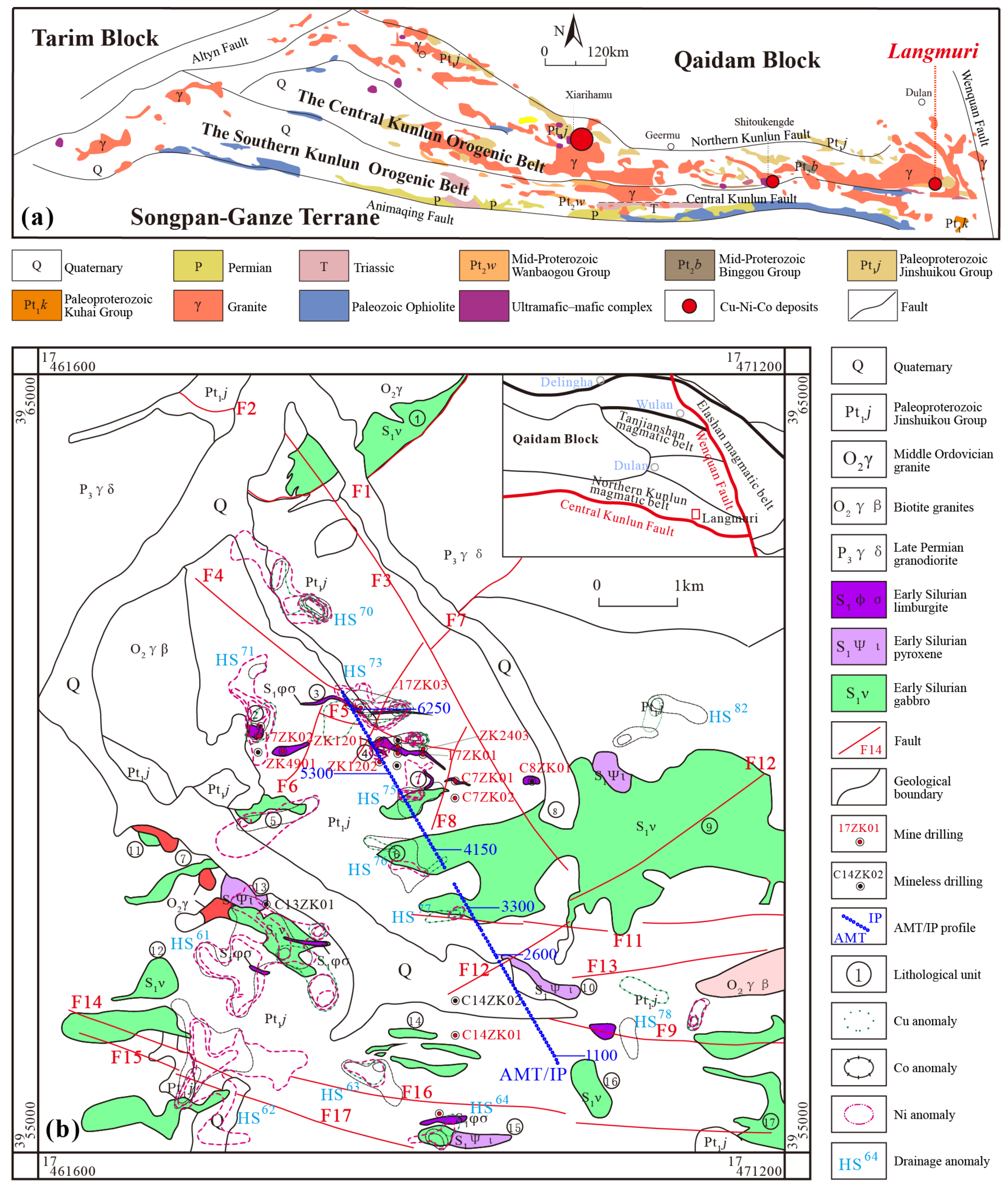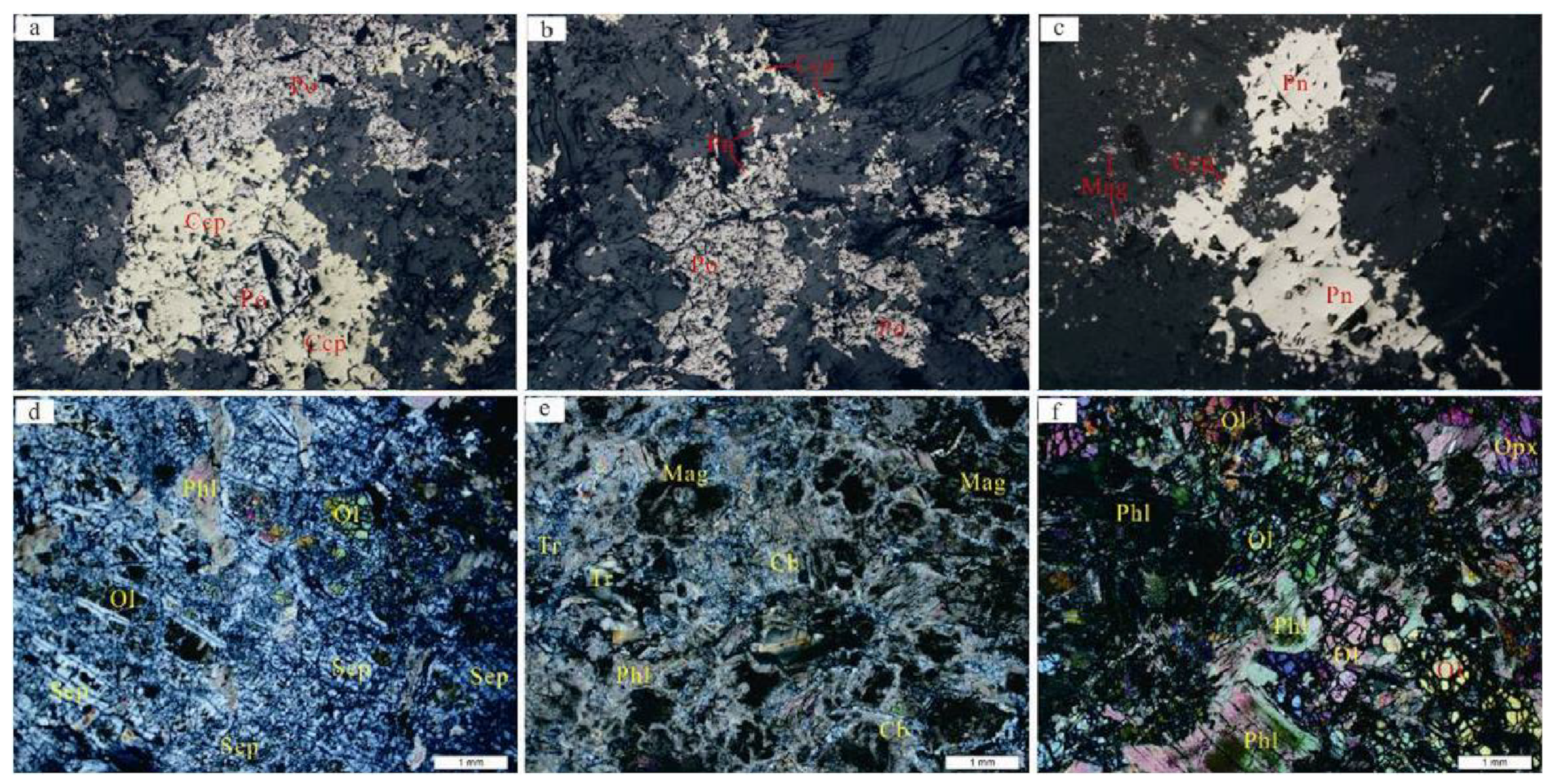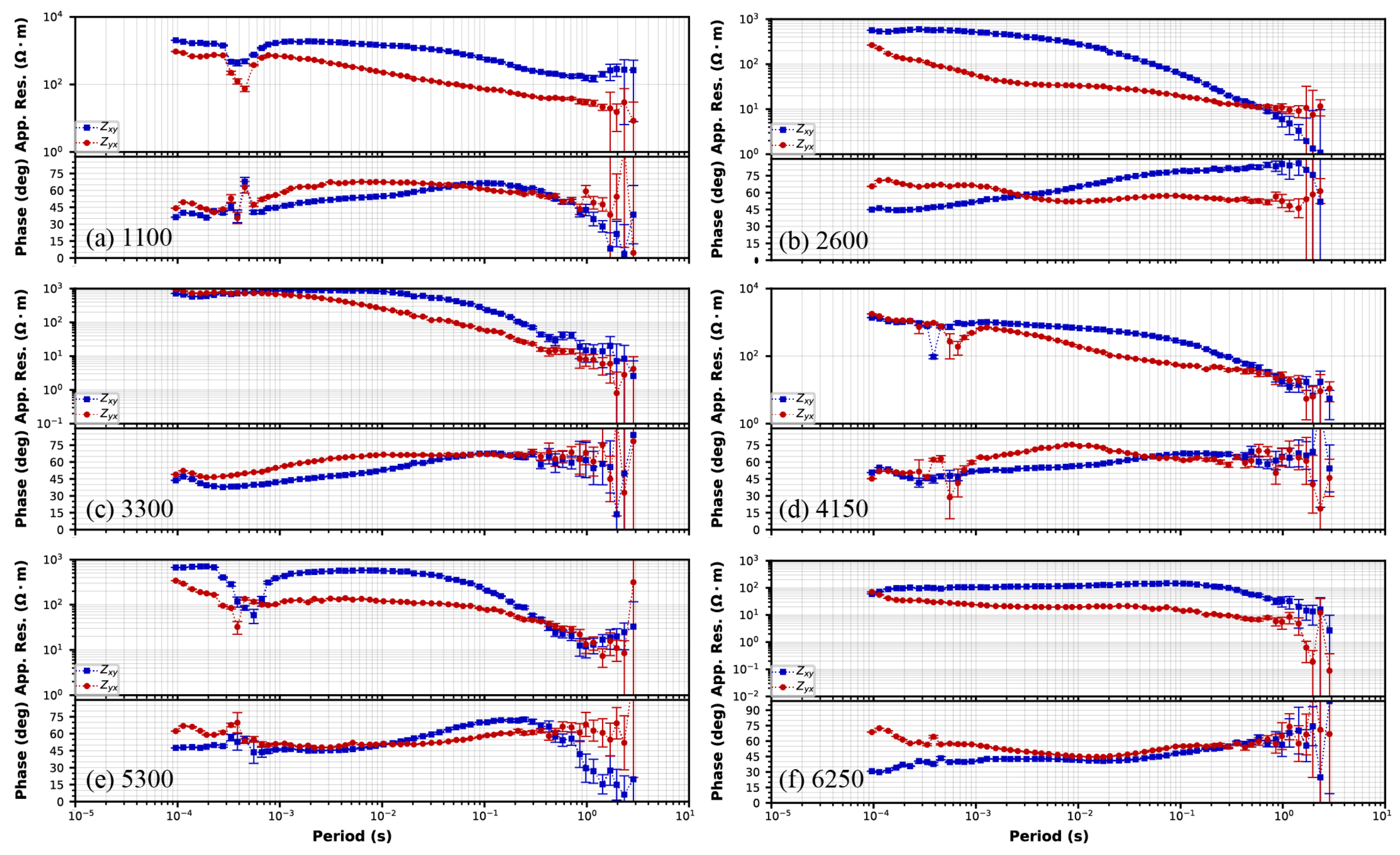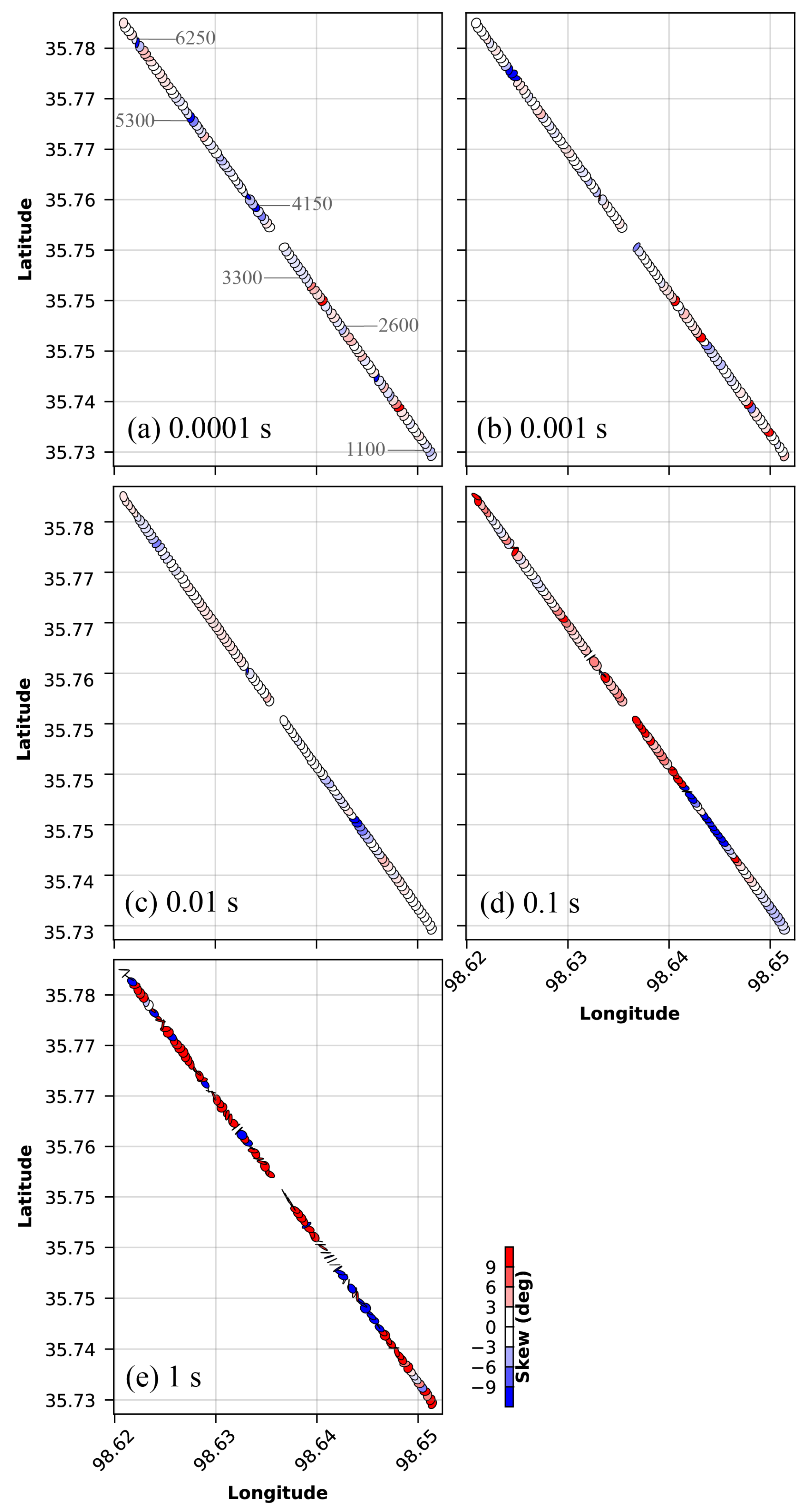Characteristics and Deep Mineralization Prediction of the Langmuri Copper–Nickel Sulfide Deposit in the Eastern Kunlun Orogenic Belt, China
Abstract
:1. Introduction
2. Geological Setting
3. Methods
4. Result
4.1. Geochemistry
4.2. Gravity and Magnetic Methods
4.3. Induced Polarization and Audio Magnetotelluric Methods
5. Discussion
- (1)
- The subduction–collision orogenic processes (initial mineralization stage) (Figure 7a). In the Cambrian–Ordovician, the extensive expansion of the Proto-Tethys Ocean occurred along the southern margin of the Qaidam block. The subduction of the oceanic crust to the north underwent melting, decompression, and differentiation, triggering intermediate-acidic magmatic activities in island arcs [45]. The subducted oceanic crust underwent melting, thinning, and detachment, resulting in the formation of slab windows, facilitating the ascent of mantle-derived magmas rich in Cu, Ni, and other elements from the deep asthenospheric mantle, which amalgamated with the lower crust at the mantle wedge to form mafic–ultramafic magmatic melts (or magma chambers) [46,47].
- (2)
- The collision of orogenic and post-extension processes (the main mineralization stage) (Figure 7b). In the Silurian, the Proto-Tethys Ocean closed, resulting in the collisional orogeny of the oceanic crust with the Qaidam block, leading to crustal compression and thickening [7,10]. The late-stage dynamics of the collision were extensional mechanisms primarily. Ore-bearing mantle-derived magnesium mafic–ultramafic magmatic melts formed at the crust–mantle boundary rose along extensional structures driven by mantle thermal dynamics and underplating the lower crust. After decompression melting, the melts underwent crust–mantle mingling with crustal material, leading to sulfide saturation. During this process, temperature and pressure decreased, resulting in the crystallization and differentiation of oxide in the magma into silicate minerals. Elements such as Cu, Ni, Co, Pt, and Pd were fractionated and mineralized as sulfides, forming a four-layer structure of silicic magma, sulfide-bearing magma (disseminate textures), sulfide-rich magma (sponge meteorite textures), and sulfide melt (massive textures) from top to bottom [48]. In the late stages of magma differentiation, with increasing fractionation, decreasing temperature and pressure, and the involvement of volatile components such as water, abundant hydrothermal fluids formed in the post-magmatic stage. These hydrothermal fluids underwent metasomatism, resulting in alterations such as carbonation, serpentinization, and PGE mineralization, ultimately forming symbiosis-associated PGE minerals [49].
- (3)
- Superimposed mineralization processes (Figure 7c). During the Devonian, the continental crust thickened, and under the deep-seated crust–mantle differentiation, the intrusion of deep-seated medium-acidic magmatic rocks occurred in Hercynian [49]. The ore bodies were destructed by the orogenic event and underwent magmatic–hydrothermal alteration. The subsequent orogenic activities led to regional uplift. Despite undergoing late-stage structural displacement, oxidation, and erosion, the Cu-Ni deposits remained largely intact, ultimately forming the Langmuri Cu-Ni sulfide deposit.
6. Conclusions
Author Contributions
Funding
Data Availability Statement
Acknowledgments
Conflicts of Interest
References
- Liu, Y.; Li, W.; Jia, Q.; Zhang, Z.; Wang, Z.; Zhang, Z.; Zhang, J.; Qian, B. The Dynamic Sulfide Saturation Process and a Possible Slab Break-off Model for the Giant Xiarihamu Magmatic Nickel Ore Deposit in the East Kunlun Orogenic Belt, Northern Qinghai-Tibet Plateau, China. Econ. Geol. 2018, 113, 1383–1417. [Google Scholar] [CrossRef]
- Zhang, Z.-W.; Wang, Y.-L.; Wang, C.-Y.; Qian, B.; Li, W.-Y.; Zhang, J.-W.; You, M.-X. Mafic-ultramafic magma activity and copper-nickel sulfide metallogeny during Paleozoic in the Eastern Kunlun Orogenic Belt, Qinghai Province, China. China Geol. 2019, 2, 467–477. [Google Scholar] [CrossRef]
- Li, W.; Gao, Y.; Bagas, L. Ore forming process of magmatic Nickel-Copper-Cobalt sulfide deposits in China. Fundam. Res. 2024, in press. [CrossRef]
- Zhang, Y.; Pan, T.; Zhang, A.; He, S.; Qian, Y.; Bai, Y. Spatial Relationship between Eclogite and Copper-Nickel Mineralization in East Kunlun, China. Minerals 2023, 13, 330. [Google Scholar] [CrossRef]
- Li, W.; Zhang, Z.; Gao, Y.; Hong, J.; Chen, B.; Zhang, Z. Tectonic transformation of the Kunlun Paleo-Tethyan orogenic belt and related mineralization of critical mineral resources of nickel, cobalt, manganese and lithium. Geol. China 2022, 49, 1385–1407. [Google Scholar] [CrossRef]
- Liu, Y.; Zhang, J.; Feng, Z.; Yang, S.; Wang, Y.; Li, J.; Zhao, Z.; Wang, Z.; Li, S.; Chen, Z.; et al. Exploration and research progress of magmatic copper-nickel-cobalt sulfide deposits in the north-eastern margin of the Qinghai-Tibetan Plateau. Geol. China 2024. [Google Scholar] [CrossRef]
- Zhang, D.; Zhang, H.; Feng, C.; She, H.; Li, J.; Li, D. Fluid inclusions in orogenic gold deposits in the northern Qaidam margin-East Kunlun region. Geol. China 2007, 34, 843–854. [Google Scholar] [CrossRef]
- Pan, Y.; Zhou, W.; Xu, R.; Wang, D.; Zhang, Y.; Xie, Y.; Chen, T.; Luo, H. Geological characteristics and evolution of the Kunlun Mountains region during the early Paleozoic. Sci. China 1996, 39, 337–347. [Google Scholar]
- Chen, G.; Pei, X.; Li, R.; Li, Z.; Chen, Y.; Liu, C.; Pei, L. Multiple Sources of Indosinian Granites and Constraints on the Tectonic Evolution of the Paleo-Tethys Ocean in East Kunlun Orogen. Minerals 2022, 12, 1604. [Google Scholar] [CrossRef]
- Zhang, X.; Zhao, X.; Fu, L.; Li, Y.; Kamradt, A.; Santosh, M.; Xu, C.; Huang, X.; Borg, G.; Wei, J. Crustal architecture and metallogeny associated with the Paleo-Tethys evolution in the Eastern Kunlun Orogenic Belt, Northern Tibetan Plateau. Geosci. Front. 2023, 14, 101654. [Google Scholar] [CrossRef]
- Wu, F.; Wan, B.; Zhao, L.; Xiao, W.; Zhu, R. Tethyan geodynamics. Acta Petrol. Sin. 2020, 36, 1627–1674. [Google Scholar]
- Zhu, R.; Zhao, P.; Zhao, L. Tectonic evolution and geodynamics of the Neo-Tethys Ocean. Sci. China Earth Sci. 2022, 65, 1–24. [Google Scholar] [CrossRef]
- Li, S.; Sun, F.; Wang, L.; Li, Y.; Liu, Z.; Su, S.; Wang, S. Fluid inclusion studies of porphyry copper mineralization in Kaerqueka polymetallic ore district, East Kunlun Mountains, Qinghai Province. Miner. Depos. 2008, 27, 399–402. [Google Scholar]
- Tong, H.; Long, L.; Wang, Y.; Zhu, X.; Li, S.; Gu, Z.; Ma, C.; Dai, Y.; Li, J.; Yu, X.; et al. Metallogenic Characteristics of Langmuri Copper Polymetallic Deposit in East Kunlun and Its Ore Prospecting Enlightenment. Earth Sci. 2023, 48, 4349–4369. [Google Scholar]
- Yang, S.; Duan, H.; Yang, Y.; Zhang, H.; Mao, S.; Xiong, S. Metallogenic characteristics of nickel-platinum-palladium deposit in Langmuri area, Qinghai. Miner. Explor. 2022, 13, 1276–1287. [Google Scholar]
- Pirajno, F.; Santosh, M. Mantle plumes, supercontinents, intracontinental rifting and mineral systems. Precambrian Res. 2015, 259, 243–261. [Google Scholar] [CrossRef]
- Chen, J.; Xu, J.; Wang, B.; Yang, Z.; Ren, J.; Yu, H.; Liu, H.; Feng, Y. Geochemical differences between subduction- and collision-related copper-bearing porphyries and implications for metallogenesis. Ore Geol. Rev. 2015, 70, 424–437. [Google Scholar] [CrossRef]
- Zheng, Y.; Chen, Y.; Dai, L.; Zhao, Z. Developing plate tectonics theory from oceanic subduction zones to collisional orogens. Sci. China Earth Sci. 2015, 58, 1045–1069. [Google Scholar] [CrossRef]
- Li, H.; Jiang, S.; Li, S.; Su, H.; Dong, J.; Li, Y.; Chen, X. Geological characteristics, ore genetic mechanism and exploration indicators of magmatic nickel. cobalt deposits in the East Kunlun Orogenic Belt. Acta Petrol. Sin. 2023, 39, 1041–1060. [Google Scholar] [CrossRef]
- Zhang, Z.; Qian, B.; Wang, Y.; Li, W.; Zhang, J.; You, M. Understanding of the Metallogenic Ore-Bearing Mechanism and Its Indication of Prospecting Direction in Xiarihamu Magmatic Ni-Co Sulfide Deposit, East Kunlun Orogenic Belt. Northwestern Geol. 2020, 53, 153–168. [Google Scholar] [CrossRef]
- Li, X.; Huang, X.; Luo, M.; Dong, G.; Mo, X. Petrogenesis and geodynamic implications of the Mid-Triassic lavas from East Kunlun, northern Tibetan Plateau. J. Asian Earth Sci. 2015, 105, 32–47. [Google Scholar] [CrossRef]
- Zhang, J.; Ma, C.; Li, J.; Pan, Y. A possible genetic relationship between orogenic gold mineralization and post-collisional magmatism in the eastern Kunlun Orogen, western China. Ore Geol. Rev. 2017, 81, 342–357. [Google Scholar] [CrossRef]
- Han, Y.; Liu, Y.; Li, W. Mineralogy of Nickel and Cobalt Minerals in Xiarihamu Nickel–Cobalt Deposit, East Kunlun Orogen, China. Front. Earth Sci. 2020, 8, 597469. [Google Scholar] [CrossRef]
- Pan, G.; Xiao, Q.; Zhang, K.; Yin, F.; Ren, F.; Peng, Z.; Wang, J. Recognition of the oceanic subduction-accretion zones from the orogenic belt in continents and its important scientific significance. Earth Sci. 2019, 44, 1544–1561. [Google Scholar]
- Wang, K.; Xiao, W.; Windley, B.F.; Mao, Q.; Ji, W.; Sang, M.; Huang, P.; Wang, P. The Dashui Subduction Complex in the Eastern Tianshan-Beishan Orogen (NW China): Long-Lasting Subduction-Accretion Terminated by Unique Mid-Triassic Strike-Slip Juxtaposition of Arcs in the Southern Altaids. Tectonics 2022, 41, e2021TC007190. [Google Scholar] [CrossRef]
- Pei, X.; Li, R.; Li, Z.; Liu, C.; Chen, Y.; Pei, L.; Liu, Z.; Chen, G.; Li, X.; Wang, M. Composition feature and formation process of Buqingshan composite accretionary mélange belt in southern margin of East Kunlun orogen. Earth Sci. 2018, 43, 4498–4520. [Google Scholar]
- Zhao, J.; Xu, G.; Yang, B.; Guo, H.; Li, D.; Ma, Z.; Wei, L.; Xiong, S. Technique and application result of 1: 25000 geochemical survey in East Kunlun, Qinghai Province. Northwestern Geol. 2018, 51, 209–217. [Google Scholar]
- Zhao, A.; Yang, M.; Chen, X.; Li, D.; Li, J.; Qi, C.; Wei, Y.; Ma, Z.; Li, Y. Geochemical characteristics and metallogenic significance of the Dulan area in the eastern section of the East Kunlun Mountains derived from large—scale micro channel system (soil) measurement. Geol. Explor. 2020, 56, 1158–1169. [Google Scholar] [CrossRef]
- Chen, X.; An, Z.; Zhang, W.; Xu, Y.; Ma, Y.; Shi, L.; Tao, Z. Geochemical characteristics and Cr metallogenic potential evaluation of the middle section of the northern margin of the Qaidam Basin. Geophys. Geochem. Explor. 2023, 47, 353–364. [Google Scholar]
- Leroy, P.; Revil, A. A mechanistic model for the spectral induced polarization of clay materials. J. Geophys. Res. Solid Earth 2009, 114. [Google Scholar] [CrossRef]
- Cross, B.; Kirkland, C.L. Petrological control on chargeability with implications for induced polarization surveys. J. Appl. Geophys. 2021, 188, 104308. [Google Scholar] [CrossRef]
- Wu, L.; Chen, L. Fast Computation of Terrain-Induced Gravitational and Magnetic Effects on Arbitrary Undulating Surfaces. Surv. Geophys. 2023, 44, 1175–1210. [Google Scholar] [CrossRef]
- Wang, G.; Zhu, Y.; Zhang, S.; Yan, C.; Song, Y.; Ma, Z.; Hong, D.; Chen, T. 3D geological modeling based on gravitational and magnetic data inversion in the Luanchuan ore region, Henan Province, China. J. Appl. Geophys. 2012, 80, 1–11. [Google Scholar] [CrossRef]
- Li, B.C.; Zhang, L.T.; Ye, G.F.; Jin, S.; Wei, W.B.; Xie, C.L.; Chen, X.R. Upper mantle thermal structure beneath the eastern margin of the Tibetan Plateau inferred from electrical structure model. Chin. J. Geophys. 2020, 63, 1043–1055. [Google Scholar]
- Guo, Z.; Xue, G.; Liu, J.; Wu, X. Electromagnetic methods for mineral exploration in China: A review. Ore Geol. Rev. 2020, 118, 103357. [Google Scholar] [CrossRef]
- Caldwell, T.G.; Bibby, H.M.; Brown, C. The magnetotelluric phase tensor. Geophys. J. Int. 2004, 158, 457–469. [Google Scholar] [CrossRef]
- Krieger, L.; Peacock, J.R. MTpy: A Python toolbox for magnetotellurics. Comput. Geosci. 2014, 72, 167–175. [Google Scholar] [CrossRef]
- Li, L.; Sun, F.; Li, B.; Li, S.; Chen, G.; Wang, W.; Yan, J.; Zhao, T.; Dong, J.; Zhang, D. Geochronology, Geochemistry and Sr-Nd-Pb-Hf Isotopes of No. I Complex from the Shitoukengde Ni–Cu Sulfide Deposit in the Eastern Kunlun Orogen, Western China: Implications for the Magmatic Source, Geodynamic Setting and Genesis. Acta Geol. Sin. Engl. Ed. 2018, 92, 106–126. [Google Scholar] [CrossRef]
- Yang, F.; Liu, G.; Zhang, H.; Yang, C.; Li, X.; Li, Q.; Li, N.; Zhang, Z. A review of geological characteristics and time–space distribution of cobalt deposits in the Central Asian Orogenic Belt, Xinjiang, Northwest China. Int. Geol. Rev. 2023, 65, 1388–1408. [Google Scholar] [CrossRef]
- McKenzie, D.; O’Nions, R.K. Mantle reservoirs and ocean island basalts. Nature 1983, 301, 229–231. [Google Scholar] [CrossRef]
- Hattori, K.H.; Arai, S.; Clarke, D.B. Selenium, tellurium, arsenic and antimony contents of primary mantle sulfides. Can. Miner. 2002, 40, 637–650. [Google Scholar] [CrossRef]
- Li, W.; Wang, Y.; Qian, B.; Liu, Y.; Han, Y. Discussion on the formation of magmatic Cu-Ni-Co sulfide deposits in margin of Tarim Block. Earth Sci. Front. 2020, 27, 276–293. [Google Scholar] [CrossRef]
- Zhang, J.; Lei, H.; Ma, C.; Li, J.; Pan, Y. Silurian-Devonian granites and associated intermediate-mafic rocks along the eastern Kunlun Orogen, western China: Evidence for a prolonged post-collisional lithospheric extension. Gondwana Res. 2021, 89, 131–146. [Google Scholar] [CrossRef]
- Li, W. The primary discussion on the relationship between Paleo-Asian Ocean and Paleo-Tethys Ocean. Acta Petrol. Sin. 2018, 34, 2201–2210. [Google Scholar]
- Torsvik, T.H.; van der Voo, R.; Doubrovine, P.V.; Burke, K.; Steinberger, B.; Ashwal, L.D.; Trønnes, R.G.; Webb, S.J.; Bull, A.L. Deep mantle structure as a reference frame for movements in and on the Earth. Proc. Natl. Acad. Sci. USA 2014, 111, 8735–8740. [Google Scholar] [CrossRef] [PubMed]
- Gao, J.; Klemd, R.; Zhu, M.; Wang, X.; Li, J.; Wan, B.; Xiao, W.; Zeng, Q.; Shen, P.; Sun, J.; et al. Large-scale porphyry-type mineralization in the Central Asian metallogenic domain: A review. J. Asian Earth Sci. 2018, 165, 7–36. [Google Scholar] [CrossRef]
- Richards, J.P.; Şengör, A.M.C. Did Paleo-Tethyan anoxia kill arc magma fertility for porphyry copper formation? Geology 2017, 45, 591–594. [Google Scholar] [CrossRef]
- Li, L.; Zhang, D.; Tan, S.; Sun, F.; Wang, C.; Zhao, T.; Li, S.; Yang, Y. The parental magma composition, crustal contamination process, and metallogenesis of the Shitoukengde Ni-Cu sulfide deposit in the Eastern Kunlun Orogenic Belt, NW China. Resour. Geol. 2021, 71, 339–362. [Google Scholar] [CrossRef]
- Jun, L.; Gui, X. Temporal-spatial distribution and geodymanic settings of magmatic Ni-Cu-(PGE)sulfide deposits in China. Acta Petrol. Sin. 2007, 23, 2561–2594. [Google Scholar]
- Shehta, E.A.; Shehata, A.; Mohamed, A.O. Geochemistry of an Alaskan-type mafic-ultramafic complex in Eastern Desert, Egypt: New insights and constraints on the Neoproterozoic island arc magmatism. Geosci. Front. 2019, 10, 941–955. [Google Scholar] [CrossRef]







Disclaimer/Publisher’s Note: The statements, opinions and data contained in all publications are solely those of the individual author(s) and contributor(s) and not of MDPI and/or the editor(s). MDPI and/or the editor(s) disclaim responsibility for any injury to people or property resulting from any ideas, methods, instructions or products referred to in the content. |
© 2024 by the authors. Licensee MDPI, Basel, Switzerland. This article is an open access article distributed under the terms and conditions of the Creative Commons Attribution (CC BY) license (https://creativecommons.org/licenses/by/4.0/).
Share and Cite
Ma, C.; Li, B.; Li, J.; Wang, P.; Dong, J.; Cui, Z.; Yang, S. Characteristics and Deep Mineralization Prediction of the Langmuri Copper–Nickel Sulfide Deposit in the Eastern Kunlun Orogenic Belt, China. Minerals 2024, 14, 786. https://doi.org/10.3390/min14080786
Ma C, Li B, Li J, Wang P, Dong J, Cui Z, Yang S. Characteristics and Deep Mineralization Prediction of the Langmuri Copper–Nickel Sulfide Deposit in the Eastern Kunlun Orogenic Belt, China. Minerals. 2024; 14(8):786. https://doi.org/10.3390/min14080786
Chicago/Turabian StyleMa, Cai, Baochun Li, Jie Li, Peng Wang, Ji’en Dong, Zhaoyu Cui, and Shunlong Yang. 2024. "Characteristics and Deep Mineralization Prediction of the Langmuri Copper–Nickel Sulfide Deposit in the Eastern Kunlun Orogenic Belt, China" Minerals 14, no. 8: 786. https://doi.org/10.3390/min14080786




